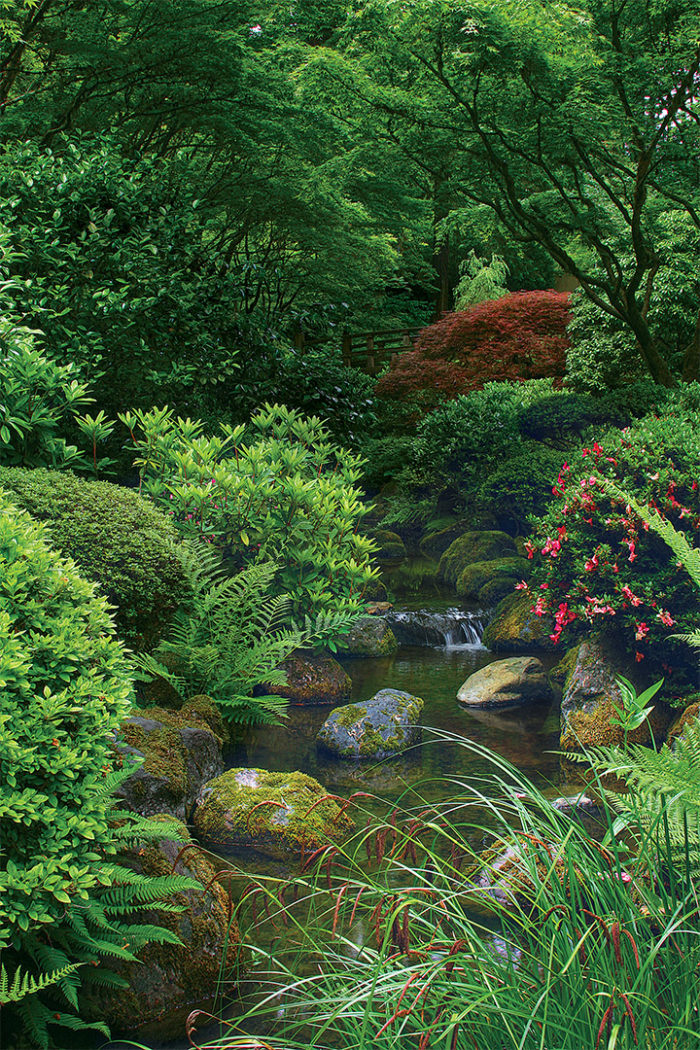
The art and craft of the Japanese garden continues to thrive today after well over 1,300 years in Japan and for the last 150 years in various points west and east. It is difficult to define one reason for the almost instant endearment of these beautiful spaces, but for me, it has always been the Japanese garden’s ability to capture the essence of the greater natural world as well as its ability to adapt to almost any type of site and topography. Most of us are only familiar with the Japanese garden in public-park settings, and while beautiful, these gardens would likely be far out of our range in terms of cost—and perhaps scale—to even be given a second thought as an option for our own homes. There are, however, elements of design within nearly all Japanese gardens that can be integrated into a non-Japanese garden with great success. The key is not to paint a Japanese face on your garden in an effort to make it look or feel authentically Japanese. Take cues, instead, from Japanese-gardening techniques to evoke the peace and tranquility that these gardens inspire. To do this, we will need to look closely at some of the elements of traditional Japanese-garden design.
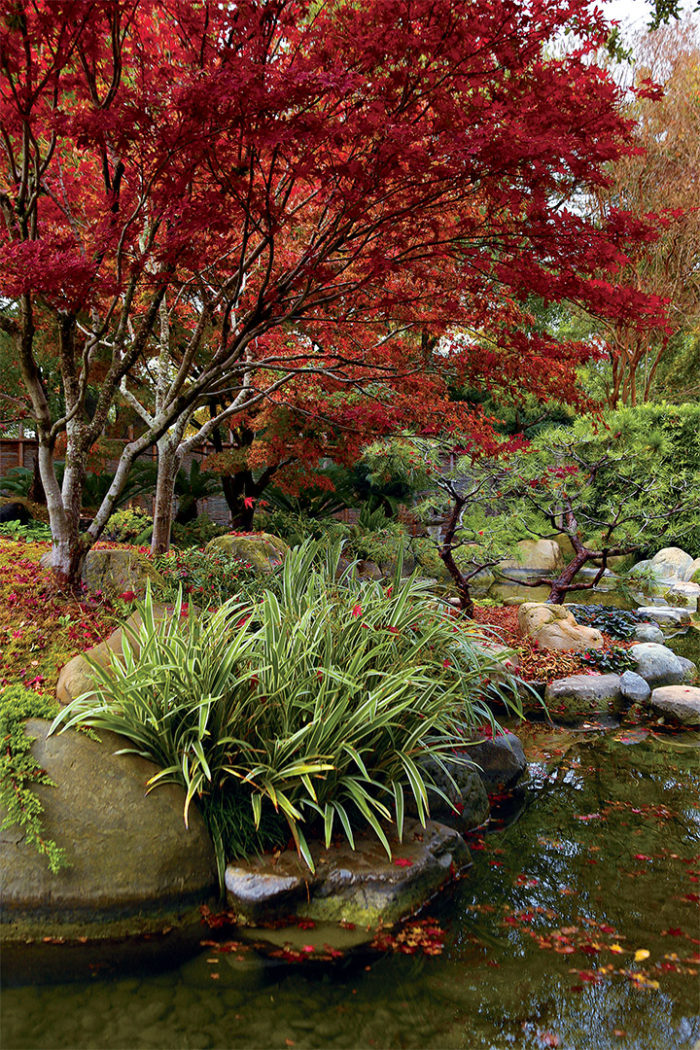
SEASONALITY
Each season is equally important
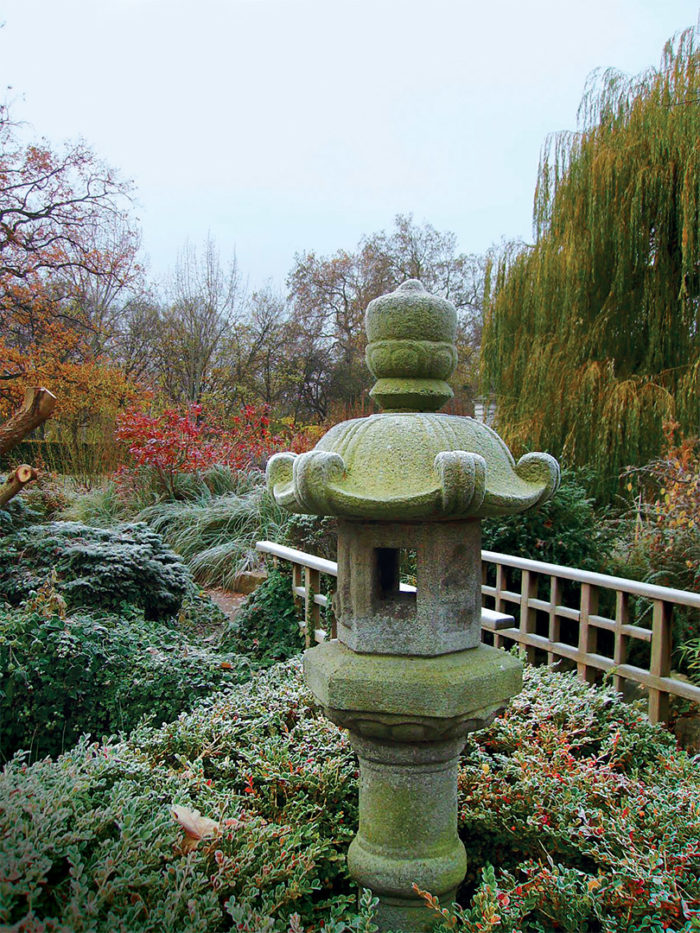
Japan is one of the few areas in the world that places such strong cultural significance on the seasons as they relate to daily life and the feelings and moods that they evoke. It’s easy to understand, then, the importance of the seasons within the garden. The best gardens in Japan, for example, would rarely, if ever, feature a Japanese-maple cultivar with red leaves during the growing season. The seasonal color change is what is desirable.
Spring is the period of rebirth, so deciduous plants that bloom or go directly into leaf are a desired feature. The goal is a brief, subdued color display that is appropriate to the season. Summer
in the Japanese garden is the season of green, rather than the riotous display of flowering shrubs and perennials often seen in western gardens. In the days before air-conditioning, nothing was more satisfying than retreating to the green of the summer garden with, perhaps, the sound of trickling water to cool you down.
Fall gives us a chance to look back, and the drop of colorful leaves signals the year’s end. Winter is a time of rest for the garden, but it is also a time to see the scaffold of the leafless trees and the way that snow dresses the evergreen plants.
Bringing it home
- Choose small, delicate, pale-colored flowers
in spring. - Opt for plants with healthy foliage in summer, rather than ones with lots of flowers.
- Feature distinct foliage-color changes and intriguing structure in fall and winter.
SPACE
Minimizing distractions lets a garden indoors
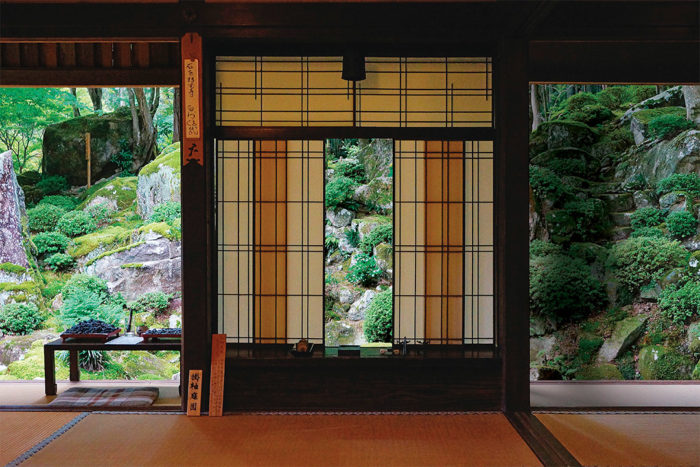
Perhaps the main thing that converted me to using the principles of Japanese gardens is the way that the Japanese home and garden are seamlessly integrated. This is largely due to Japanese homes featuring floor-to-ceiling views of the garden, which effectively brings the outside into the house. While many of our homes feature windows that can only be looked through while standing, others have homes with sliding doors and floor plans not unlike the traditional Japanese home.
That said, when the garden is intended or has the potential to be viewed from a fixed location, such as inside the house, there shouldn’t be distraction or clutter in between to diminish the experience. Avoid planting right outside a window. Not every inch needs to be filled with plants or stone groupings. There needs to be empty space—such as a lawn area, a sea of gravel, or a pond—that gives the viewer a sense of depth.
Also, numerous techniques allow us also to trick the eye into believing that the garden is wider or deeper than it is. A long, narrow space, for example, might use sparse planting in the foreground with increasingly heavier plantings in the middle and back to constrict the rectangular shape of the site and make the viewer look to just one distant vantage point.
Bringing it home
- Add or take advantage of floor-to-ceiling windows.
- Avoid planting right outside of a window.
- Provide space in the foreground of a view.
- Manipulate a view to make it seem more spacious.
QUALITY
Good materials and careful maintenance shine through
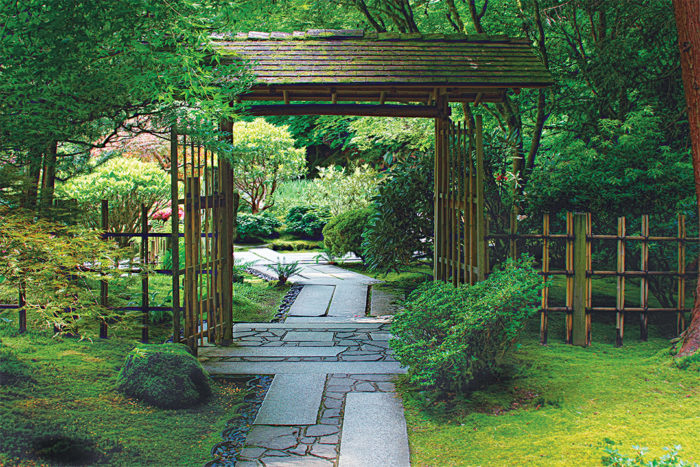
Selecting the best possible materials is important in constructing any garden. Become familiar with the materials available to you before you start. High-quality materials can be expensive, and it is better to wait until they fit your budget than to compromise and go with inferior materials just to get the job done. Consulting with a professional, as well, might be well worth the investment. When it comes to plants, consider species that are well adapted to your area, even though they might not be what you would immediately consider typical for a Japanese garden. Likewise, take into account the maintenance that a plant will require in the beginning to save you headaches—and an overgrown mess—later. A well-maintained garden of marginal design will far outshine the best-designed garden that is given no care.
Bringing it home
- Wait until you can afford quality materials instead of settling for inferior quality.
- Opt for plants suited to your conditions.
- Keep up with maintenance to ensure that the elements of your garden look their best.
SUBTLETY
Less is more
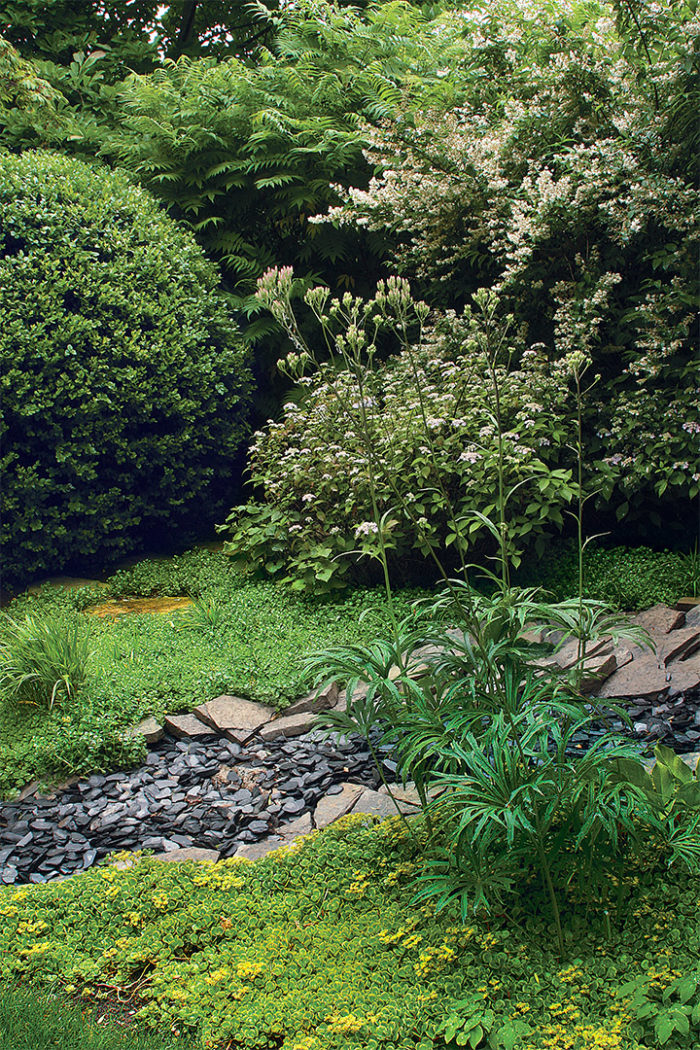
We have all heard the phrase “too much of a good thing.” Overpowering a garden with a poor architectural choice, ostentatious stone groupings, or too many specimen trees gives the viewer a sense of uneasiness, which is the opposite of our goal. Lanterns and pagodas, for example, have a place in some gardens, but if they are used as the element to define the space as a Japanese garden, it would be better to start over and find a path that did not require their use for credibility. Directional signs and plant labels should also be avoided because they are unnecessary and clutter the garden.
Japanese gardens are not collections of Japanese plants but, rather, arrangements of plants and materials that evoke landscape scenery. When we try to create an area that makes us think of the mountains, a meadow, or the seashore, we use the plants that commonly grow there. To create a scene where no one part overpowers the rest, avoid mixing wildly contrasting foliage textures and colors in favor of a more harmonious blend of plants.
Bringing it home
- Avoid ostentatious art or stone groupings.
- Remove anything that’s unnecessary or that adds clutter to the garden.
- Use harmonious combinations of plants rather than opting for strong contrast.
PROPORTION
Keeping things in scale helps evoke the right mood
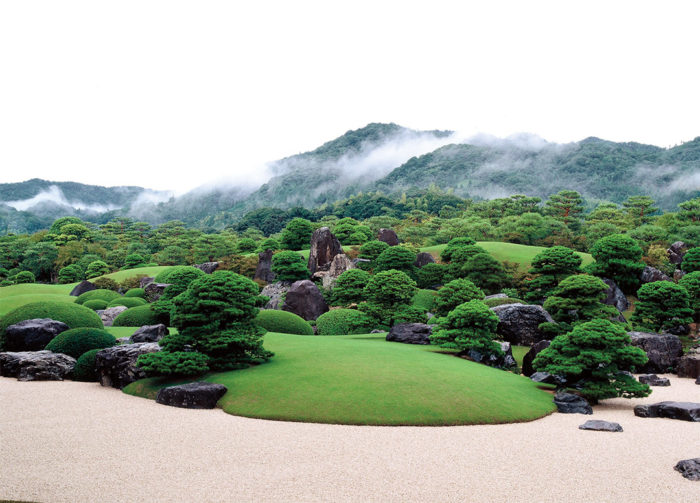
The well-conceived garden should have landforms, plantings, and pathways that relate in scale to the size of the human body. This makes the viewer feel familiar with the site conditions and, thus, more comfortable. Japanese gardens are created on this human scale, sometimes by using techniques of abstract representation or distilling the essence of the scenic parts of the natural world to impart their mood to the garden. When using large stones to evoke the feeling of mountains or a water course, for example, it is important to use a variety of sizes and shapes to effectively replicate what we see in nature. Similarly, plants must be selected and maintained at a variety of sizes and shapes in an effort to offer a feeling of old and new. This keeps the view from becoming stagnant with plantings that have grown to a similar size and offer little variation for the eye to move up and down naturally through the composition.
If you consider the variously arranged garden stones and contour of the land as the skeleton of the garden, then it is equally important to consider the ideal size of the attending plantings; that’s because the stones and mounds do not get any bigger, while the plantings do. The solution in Japan has been to prune all plants in the garden to keep them in proportion to the layout of the rest of the garden, but this can be accomplished with careful plant choices, as well.
It is rare to see large shade trees in a garden in Japan, simply because they are out of proportion with the rest of the garden. These trees are reserved for parks and temple gardens where their size is better in scale with the surrounding space and the architecture. Large shade trees are a common feature of American gardens, however, and often a necessity for summer shade. A way to keep these trees is to use additional plantings of smaller trees that transition the height of the trees back to the ground plane so that they aren’t disproportionately larger than everything else in the garden.
Bringing it home
- Keep the height of walls, the width of pathways, and the size of plantings relative to the human body.
- Use a variety of plant sizes to help the eye move around the space.
- Balance large trees with gradually smaller trees and shrubs to bring them into scale.
DESIGN
It’s not about the lantern
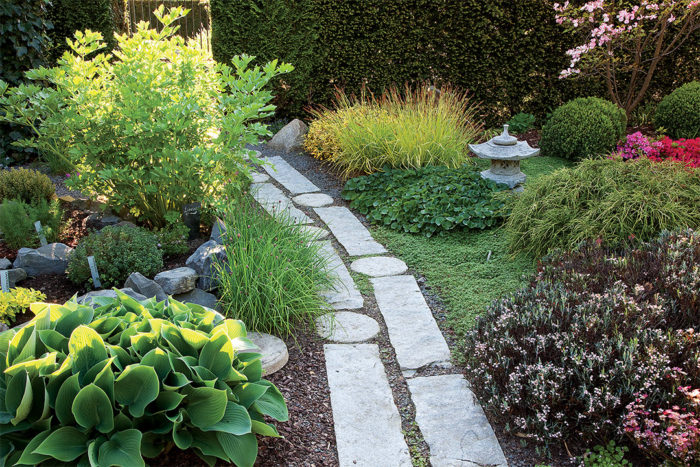
Creating a mood similar to one found in a traditional Japanese garden doesn’t mean that you have to have bamboo and Japanese stone lanterns everywhere. Here are some ways to add some serenity to your garden. (A lantern is optional.)
Go easy on contrast and color
Color and contrast are wonderful for making an exciting garden, but the power of a Japanese garden comes from its ability to evoke a sense of calmness from the visitor. This vignette has very few bright colors—and even those are kept small and far away.
Stay in scale
When the size of the elements of a garden are too large, a person feels
insignificant; when they are too small, one can feel clumsy and awkward. By keeping this path just the right width for a person to walk on and keeping the plantings down to a size where one can interact with them, this vignette has a scale that contributes to the peaceful mood of the space.
Feel free to have nothing
Gardeners often have the impulse to put a plant into any open space that they see. But the empty spaces between plants gives everything room to create its own impact. This vignette makes use of gravel and low ground covers to allow everything to breathe.
John Powell is a designer specializing in Japanese gardens in Weatherford, Texas.



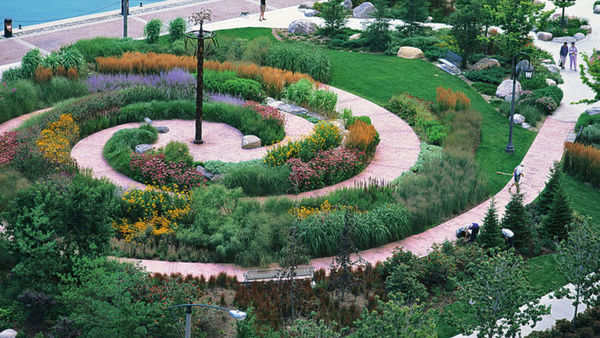













Comments
Hello, Mr Powell. Love your pics as I love the simplicity and "mostly green" of Japanese gardening. I would appreciate knowing the name of the plant with the sweet, tiny pink flowers in the lower right of the last photo. Thank you.
Erla
Great! It would be nice if you write more about japanese garden style and include more photos, can use this source btw https://radybydleni.cz/media/japonska-zahrada-fotogalerie-inspirace
Or better, something made by you.)
Log in or create an account to post a comment.
Sign up Log in